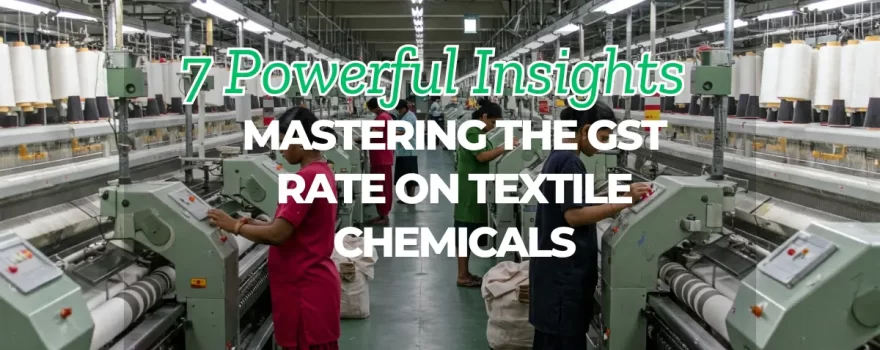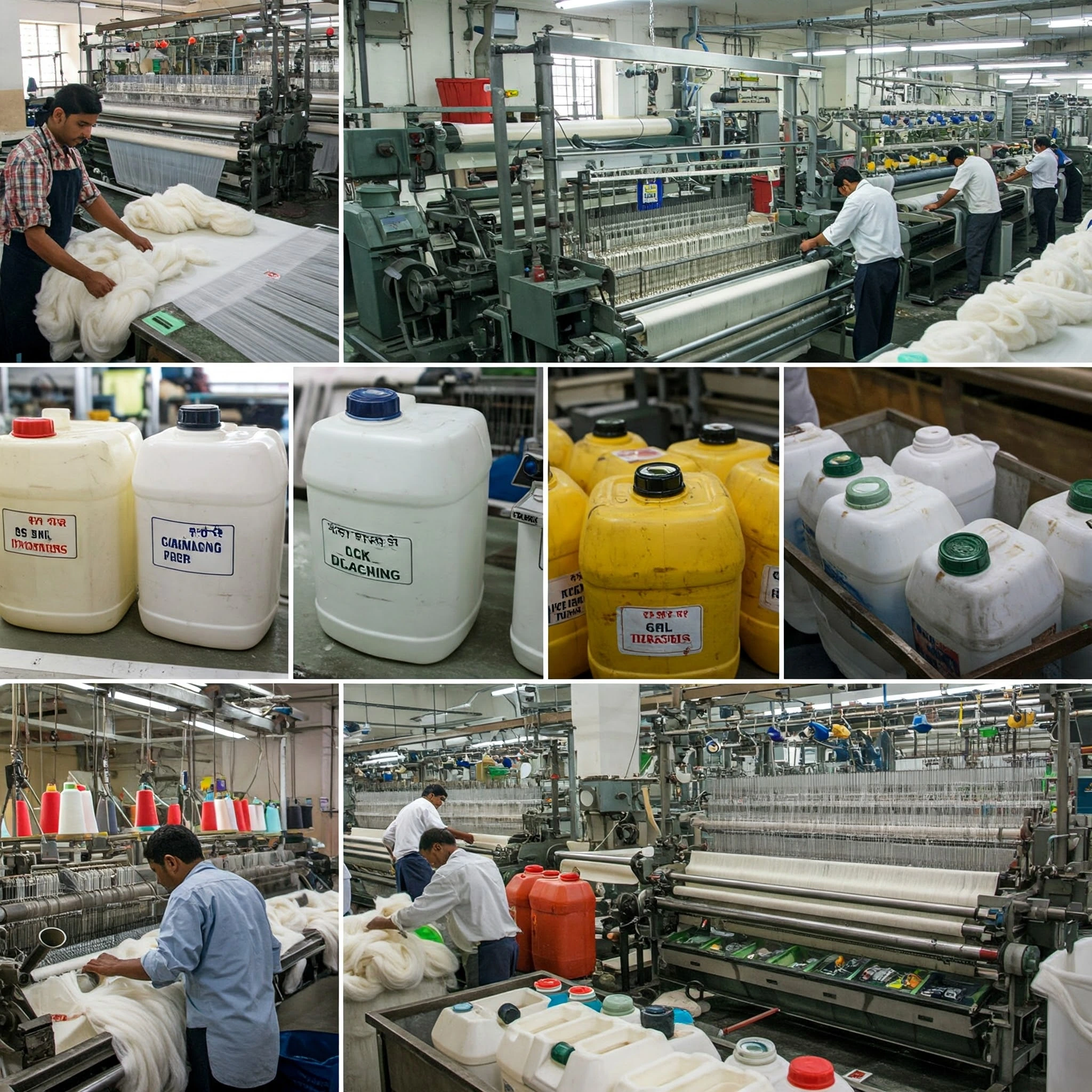
Table of Contents
GST on textile chemicals affects the entire textile supply chain. Understanding these rates is essential for compliance and accurate pricing.
Introduction to GST on Textile Chemicals
GST on textile chemicals is a key part of India’s tax system. It impacts all involved in the textile industry. Accurate rate knowledge is crucial for financial compliance.
GST Applicability in the Textile Chemical Industry
GST application in the textile chemical sector depends on product types and sales. Raw materials, intermediates, and finished goods may have different rates. Interstate sales attract IGST, while intrastate sales involve CGST/SGST. Exemptions exist. Businesses must know these details for compliance.
Current GST Rate on Textile Chemicals in India
In India, the Goods and Services Tax (GST) rates applicable to textile chemicals differ based on the particular chemical and its classification. Generally, these chemicals fall under the 12% or 18% GST slabs.
Certain basic chemicals used in textile processing.
Some dyeing and coloring materials.
12% G
18% GST:
Most specialized finishing agents and auxiliary chemicals.
Other complex chemical compounds used in textile manufacturing.
It is important to note that the GST council periodically revises these rates. Therefore, staying updated with the latest notifications is essential. For precise classification and current rates, consulting the official GST portal or a tax professional is always advisable.
Classification of Textile Chemicals Under GST
The classification of textile chemicals under GST relies on the Harmonized System of Nomenclature (HSN) codes. These codes serve to categorize items, facilitating consistent application of taxes. Here is a straightforward summary:
The composition and intended use determine the precise HSN code.
Dyes and Coloring Agents:
These often fall under Chapter 32 of the HSN code.
Specific subheadings dictate the exact GST rate.
Finishing Agents:
These may be classified under Chapter 38.
The composition and intended use determine the precise HSN code.
Sizing Agents:
These also fall under chapter 38, but have very specific subheadings.
Other Auxiliary Chemicals:
This broad category can include various chemicals used in textile processing.
Their classification depends on their chemical composition and function.
It’s critical to use the correct HSN code. Incorrect classification can lead to penalties and tax discrepancies. Always refer to the official GST tariff for accurate coding.
GST Rate on Textile Chemical
Impact of GST on Textile Chemical Manufacturers and Suppliers
GST implementation has brought both challenges and benefits to textile chemical manufacturers and suppliers.
Positive Impacts:
Simplified Tax Structure: GST replaced multiple indirect taxes, streamlining the tax process. This reduces the compliance burden.
Input Tax Credit: Manufacturers and suppliers can claim input tax credit, reducing the overall tax liability. This can lead to lower production costs.
Unified Market: GST created a unified national market, facilitating smoother interstate trade. This expands market access.
Challenges:
Classification Issues: Correctly classifying textile chemicals under HSN codes can be difficult. This can lead to disputes and penalties.
Compliance Burden: While simplified, GST still requires regular filing and compliance. This can be time-consuming, especially for smaller businesses.
Working Capital: The initial transition to GST and the delay in receiving input tax credits can strain working capital.
Rate Variations: The varying GST rates on different chemicals require careful tracking and accounting.
Essentially, while GST aims for efficiency, businesses must remain vigilant about classification and compliance to fully leverage its advantages.
Comparison of Pre-GST and Post-GST Taxation on Textile Chemicals
The shift from the pre-GST regime to the current GST system has significantly altered the taxation landscape for textile chemicals. Here’s a comparative overview:
| Feature | Pre-GST Regime | Post-GST Regime |
| Tax Structure | Multiple indirect taxes (Excise Duty, VAT, CST, etc.) | Unified GST (CGST, SGST, IGST) |
| Tax Cascading | Cascading effect due to taxes levied at multiple stages | Eliminated through input tax credit |
| Interstate Trade | Complex due to CST and varying state VAT rates | Simplified with IGST |
| Interstate Trade | Complex due to CST and varying state VAT rates | Simplified with IGST |
| Compliance | Multiple returns and compliances | Consolidated returns and simplified compliance |
| Tax Rates | Varying and complex rates across different states | Standardized GST rates across the nation |
| Input Tax Credit | Limited and complex | Broad and simplified |
Key Changes:
- The most significant change is the move from a complex, multi-tax system to a unified GST.
- The elimination of the cascading effect has reduced the overall tax burden.
- Simplified interstate trade has enhanced market access.
- Input tax credit availability has increased.
This transition has aimed to create a more transparent and efficient tax environment.
GST Compliance and Filing Requirements for Textile Chemical Businesses
Adhering to GST compliance is paramount for textile chemical businesses. Here’s a rundown of the key requirements:
Invoices must include details like GSTIN, HSN codes, and tax rates.
Registration:
Businesses with an aggregate turnover exceeding the threshold limit must register under GST.
Registration involves obtaining a GSTIN (Goods and Services Tax Identification Number).
Invoicing:
All taxable supplies must be accompanied by GST-compliant invoices.
Businesses with an aggregate turnover exceeding the threshold limit must register under GST.
Returns Filing:
Businesses must file regular GST returns, including:
GSTR-1 (outward supplies)
GSTR-3B (summary return)
GSTR-9 (annual return)
Deadlines for filing returns must be strictly followed to avoid penalties.
Input Tax Credit (ITC):
Businesses can claim ITC on eligible purchases.
Accurate records of purchases and input tax are essential.
ITC matching between GSTR-2A/2B and purchase records is necessary.
Record Keeping:
Maintaining accurate records of sales, purchases, and tax payments is crucial.
Records should be kept for a specified period as per GST regulations.
HSN Code Accuracy:
Correctly declaring HSN codes in invoices and returns is essential.
This ensures accurate tax liability and avoids discrepancies.
Consistent adherence to these requirements is crucial for smooth business operations and avoiding legal complications.
Challenges Faced by the Textile Chemical Sector Due to GST
Despite its benefits, GST has presented several challenges for the textile chemical sector:
HSN Code Discrepancies:
Accurate classification of complex chemicals under HSN codes remains a significant hurdle.
Variations in interpretation can lead to disputes and penalties.
Working Capital Issues:
Delays in receiving input tax credits can strain working capital, especially for small and medium-sized enterprises (SMEs).
The initial transition to GST also created temporary cash flow problems.
Compliance Burden:
Regular filing of GST returns and maintaining detailed records can be time-consuming and resource-intensive.
This burden is particularly heavy for businesses with limited administrative capacity.
Rate Variations and Complexity:
The existence of multiple GST rates (12% and 18%) for different textile chemicals adds complexity to pricing and accounting.
Frequent changes in GST rates and regulations require constant monitoring.
Adaptation to New Technology:
GST compliance necessitates the use of online portals and software, which can be challenging for businesses with limited technological infrastructure.
Transitioning to new online filing systems.
Interstate trade issues:
Although simplified, issues still arise with interstate transactions, especially regarding input tax credit matching between states.
GST Rate on Textile Chemicals
- Government Policies and Recent Amendments Related to GST on Textile Chemicals
Government policies and amendments play a critical role in shaping the GST landscape for textile chemicals. Here’s a look at some key aspects:
Regular Rate Revisions:
The GST Council periodically reviews and revises GST rates. These revisions aim to address industry concerns and align tax structures with economic realities.
Staying updated on these changes is crucial for businesses.
HSN Code Clarifications:
The government issues clarifications and amendments to HSN codes to resolve classification disputes.
These clarifications provide greater certainty for businesses.
Input Tax Credit (ITC) Enhancements:
Policies focus on streamlining ITC processes to reduce delays and improve cash flow for businesses.
Efforts are made to minimize ITC mismatches and simplify reconciliation.
Compliance Simplification:
The government aims to simplify GST compliance through technological advancements and process improvements.
This includes initiatives like e-invoicing and automated return filing.
Support for SMEs:
Policies are designed to support small and medium-sized enterprises (SMEs) in the textile chemical sector.
This includes providing training, resources, and simplified compliance options.
Anti-Profiteering Measures:
The government enforces anti-profiteering measures to prevent businesses from unfairly increasing prices due to GST rate reductions.
This ensures that the benefits of reduced tax burden is passed on to the end consumer.
Addressing Industry-Specific Issues:
The government has shown a willingness to address specific challenges faced by the textile chemical sector.
This involves engaging with industry stakeholders and implementing targeted solutions.
GST Exemptions and Concessions for Textile Chemical Industry
Certain exemptions and concessions under GST aim to alleviate the tax burden on the textile chemical industry. These provisions support specific processes and promote industry growth.
Exemptions for Specific Processes:
Certain chemicals used in specific textile manufacturing processes may be exempt from GST.
These exemptions often target processes deemed essential for the industry’s sustainability.
Concessional Rates:
The government may provide concessional GST rates for specific textile chemicals.
These reduced rates aim to lower production costs and enhance competitiveness.
Job Work Exemptions:
GST exemptions may apply to job work involving textile chemicals.
This supports businesses that outsource specific processing stages.
Export Incentives:
Exported textile chemicals may be eligible for zero-rated GST or refunds.
These incentives promote exports and enhance the industry’s global competitiveness.
Research and Development:
Chemicals used in research and development activities within the textile sector may receive exemptions.
This encourages innovation and technological advancement.
Environmental Considerations:
Environmentally friendly textile chemicals may be eligible for tax concessions.
State-Specific Incentives:
This supports sustainable practices within the sector.
Individual state governments may offer additional GST concessions or exemptions.
These incentives aim to attract investment and promote regional development.
Businesses should stay informed about these exemptions and concessions to optimize their tax liabilities.
Future Trends and Expected Changes in GST for Textile Chemicals
The GST framework is dynamic, and several trends and changes are anticipated for the textile chemical sector.
Increased adoption of e-invoicing and automated return filing is expected.
Further Rate Rationalization:
The GST Council may continue to rationalize GST rates, aiming for fewer tax slabs.
This would simplify compliance and reduce ambiguity.
Enhanced Automation and Technology:
Increased adoption of e-invoicing and automated return filing is expected.
These codes classify products, ensuring uniformity in tax implementation. Below is a simplified overview.
Improved HSN Code Clarity:
Ongoing efforts to refine and clarify HSN codes will continue.
This will minimize classification disputes and enhance accuracy.
Focus on Compliance Analytics:
The government will likely leverage data analytics to identify and address compliance gaps.
This will lead to more targeted enforcement.
Emphasis on Sustainability:
GST policies may increasingly incentivize the use of eco-friendly textile chemicals.
This will promote sustainable practices and environmental protection.
Greater Integration with Global Standards:
Alignment of GST regulations with international trade standards is expected.
This will facilitate smoother cross border transactions.
Strengthening of Input Tax Credit Mechanism:
The process of receiving ITC is expected to be further improved, and any discrepancies will be addressed quicker.
This will help small and medium sized businesses greatly.
Conclusion and Key Takeaways
Navigating GST for textile chemicals requires diligence. Key takeaways include:
- HSN Code Accuracy: Precise classification is paramount. Incorrect codes lead to penalties.
- Rate Vigilance: GST rates fluctuate; stay updated on changes.
- Compliance is Crucial: Timely filing and accurate records prevent issues.
- ITC Optimization: Maximize input tax credit to reduce costs.
- Policy Awareness: Understand exemptions and concessions.
- Adapt to Changes: The GST system evolves; be prepared to adapt.
- Seek Expert Advice: When in doubt, consult tax professionals.
Ultimately, a thorough understanding of GST ensures smooth operations and financial stability in the textile chemical sector.

